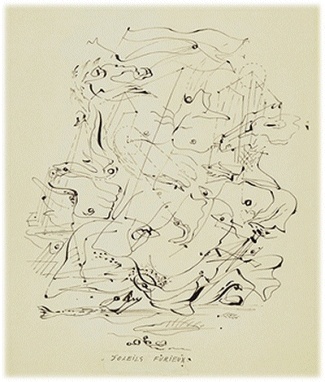|
||
|
|
Abstract tendencies in Surrealist art Surrealism, a schismatic1 outgrowth of Dadaism, was annonnced in Paris in 1924. Many of the more important Surrealist artists had been Dadaists, notably Arp, Ernst and Man Ray. Like the Dadaists the Surrealists also "claimed" Chirico and Klee, to whom they added Picasso. Masson and Miro were, Tanguy, Giacometti and Dali still are, official members of the movement. Surrealism was, like Dadaism, a point of view, a faith, almost a way of life. The Surrealists developed and codified2 the theories of the Dadaists. Like them they advocated absolute spontaneity and license3 and despised all conventional systems of values; but, unlike the Dadaists, their anarchy was systematic. In their rejection of the rational and intellectual in favor of the subconscious world of impulse they looked for sanction4 to Freud and the psychology of the subconscious. Many of their paintings and drawings are the result of automatic technique or of an attempt to recapture the atmosphere of dreams - both related to psychoanalytic method. Like the Dadaists they discovered values in the commonplace curiosities and bizarre banalities of popular art but they had little interest in machine esthetic which had been so important in Dadaism. They turned, rather, to primitive art as a revelation of unspoiled group expression and to the art of the insane and of children as the uninhibited expression of the individual. ... Abstract art, it should be clearly understood, was no more a part of the Surrealist program than it had been of Dada. From a strictly Surrealist point of view an abstract design is merely a by-product. For instance a Picasso collage, considered not as a pattern of line and texture but from the point of view of subject-matter, as a representation of a still life, is sufficiently bizarre to excite the Surrealist emotion of disquieting amazement. But, to reverse the point of view, Masson's pastel and Tanguy's drawing, whatever their Surrealist significance may be, are even more abstract than Picasso's collages and may be considered one of the results of the early 20th century impulse towards abstract design. Surrealist painting may be divided into two kinds. The first might be called automatic pictures; the second dream pictures. The first kind suggests a maximum of technical spontaneity, a direct record of an uncensored graphic or pictorial impulse. To this category belongs much of the Surrealist work of Masson, Miro, Arp and often of Ernst and Picasso. The second kind of Surrealist painting also depends upon spontaneity of imagination but not of technique. Chirico, in his work of 1910-20, Tanguy, Dali, Magritte and often Ernst, in their effort to make as convincing as possible a fantastic or dream-like world, use a technique as realistic and deliberate as that of a Flemish or Italian master of the 15th century. Source: Cubism and Abstract Art by Alfred H. Barr, Jr., The Museum of Modern Art, New York 1936, pp. 179/80 Annotations: 1. schismatic = abgespalten, abtrünnig 2. to codify = festschreiben, kodifizieren 3. license = künstlerische Freiheit 4. sanction = Billigung, Unterstützung Assignments:<br> 1. How does surrealism distinguish from dadaism? 2. What are the typical features of surrealism? 3. How does Picasso's 'Still life with guitar' differ from the two paintings by Tanguy? 4. Why are Masson's and Miro's paintings typical of surrealism, but in what respect are they different? 5. Which of above paintings appeals to you? Substantiate your choice. (If no painting appeals to you, say why not). |
| © 1997-2024 englischlehrer.de × Alle Rechte vorbehalten. × Ausgewiesene Marken gehören ihren jeweiligen Eigentümern. englischlehrer.de übernimmt keine Haftung für den Inhalt verlinkter externer Internetseiten. 2.274 (+0)pi × search powered by uCHOOSE |
|





